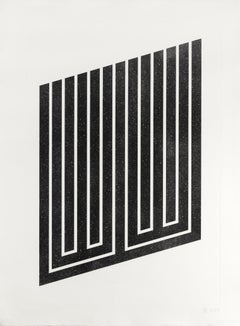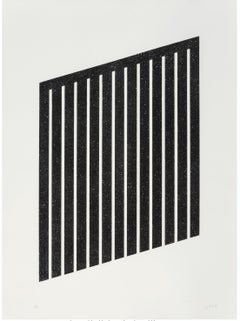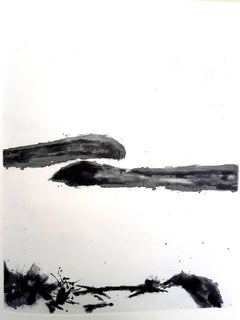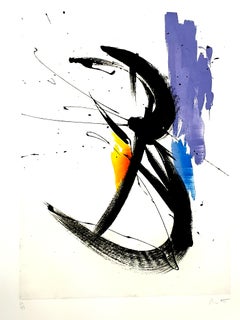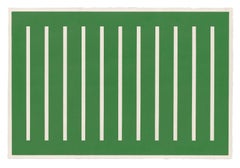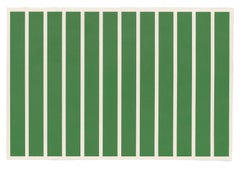Donald Judd More Prints
Many consider Donald Judd one of the most influential artists of the 20th century. Three decades after death, his ideas still hold a strong influence in the fields of architecture, interior design, criticism and art.
Judd was the voice of minimalism, rejecting through his art expressions of metaphysical and metaphorical symbolism. He sought to convey the literal, physical characteristics of each project he worked on. Judd's fascination with hard-edged imagery — especially squares and boxes — is prevalent through many of his sculptures, prints and paintings, and perfectly expresses his pragmatic artistic vision.
Even though he was a minimalist in practice, Judd appreciated various forms and styles of art, with a special fondness for Abstract Expressionism. He spent many years writing as an art critic and spoke extensively on behalf of artist culture.
Born in Excelsior Springs, Missouri, Judd joined the U.S. Army in 1946 and served in Korea until 1947. After returning home, he attended Columbia University, where he studied art history and philosophy while concurrently painting at the Art Students League.
Judd continued to paint until the early 1960s, when he abandoned the practice entirely in favor of sculpture. He found painting to be too illusionary and preferred the tactility of working in three dimensions.
As a strong proponent for art permanency, Judd purchased and refurbished many properties in Manhattan from the 1970s to the 1990s — primarily for the purpose of providing space to permanently hold and display his work and that of his colleagues. He obtained buildings throughout the downtown Cast Iron District. Other artists with the means to do so followed suit and helped develop the area, which is now known as SoHo — world-famous for cultivating artistic culture. Judd headed other political actions aimed at fostering artistic community and maintaining a healthy environment throughout New York City, especially in Manhattan.
In 1981, Judd moved with his wife, Julie Finch, to Marfa, Texas, where they established the Chinati Foundation. The 340-acre foundation site holds many of his own permanent installations and those of a number of his contemporaries, including American artists Dan Flavin, Carl Andre and John Wesley, as well as Russian artist Ilya Kabakov and many others.
Judd died from lymphoma in 1994, but a magnificent body of his work remains for all to relish for generations to come.
On 1stDibs, find a selection of Donald Judd abstract prints, interior prints and sculptures.
Late 20th Century Contemporary Donald Judd More Prints
Aquatint
20th Century Minimalist Donald Judd More Prints
Aquatint
1990s Abstract Expressionist Donald Judd More Prints
Aquatint
1990s Abstract Expressionist Donald Judd More Prints
Aquatint
1970s Abstract Donald Judd More Prints
Aquatint
1970s Abstract Expressionist Donald Judd More Prints
Aquatint
1970s Pop Art Donald Judd More Prints
Etching, Aquatint, Lithograph
1950s Abstract Donald Judd More Prints
Aquatint
1980s Modern Donald Judd More Prints
Color, Etching, Aquatint
1970s Contemporary Donald Judd More Prints
Engraving, Etching, Printer's Ink, Archival Paper, Aquatint
1980s Contemporary Donald Judd More Prints
Watercolor, Aquatint
Mid-20th Century Abstract Donald Judd More Prints
Etching, Aquatint
1970s Abstract Expressionist Donald Judd More Prints
Aquatint
1970s Contemporary Donald Judd More Prints
Printer's Ink, Archival Paper, Engraving, Etching, Aquatint
1990s Minimalist Donald Judd More Prints
Woodcut
1990s Minimalist Donald Judd More Prints
Woodcut
1990s Minimalist Donald Judd More Prints
Woodcut
1990s Minimalist Donald Judd More Prints
Woodcut
1970s Minimalist Donald Judd More Prints
Lithograph
Donald Judd more prints for sale on 1stDibs.
Artists Similar to Donald Judd
- What inspired Donald Judd?1 Answer1stDibs ExpertMay 5, 2023Donald Judd was inspired by manufacturing and industry. He was primarily interested in working with industrial materials, and the geometric structures that his fabricators made — he called them “stacks” and “progressions.” They were intended to be installed on the floor, hung from the ceiling or attached to the wall. His choice to remove the “handmade” part of his work was deliberate, as were the materials and the forms with which he worked. This spoke to Judd’s examination of space as well as the use of space, and the room-sized installations that followed for the artist in the years to come were grounded in the same ideas. On 1stDibs, find a selection of Donald Judd art and furniture.
- 1stDibs ExpertApril 5, 2022Donald Judd first entered the art world publicly as a critic and while writing, he moved away from abstract painting into linear sculptures. His very linear approach helped him become a pioneer of the mid-20th-century Minimalism. He embraced three-dimensional work while simultaneously disavowing the term Minimalist. Shop a selection of Donald Judd pieces from some of the world’s top art dealers on 1stDibs.
